新世纪版英语高三年级第二学期 Unit 1 Two Generations-课件(共32张PPT)
文档属性
| 名称 | 新世纪版英语高三年级第二学期 Unit 1 Two Generations-课件(共32张PPT) | 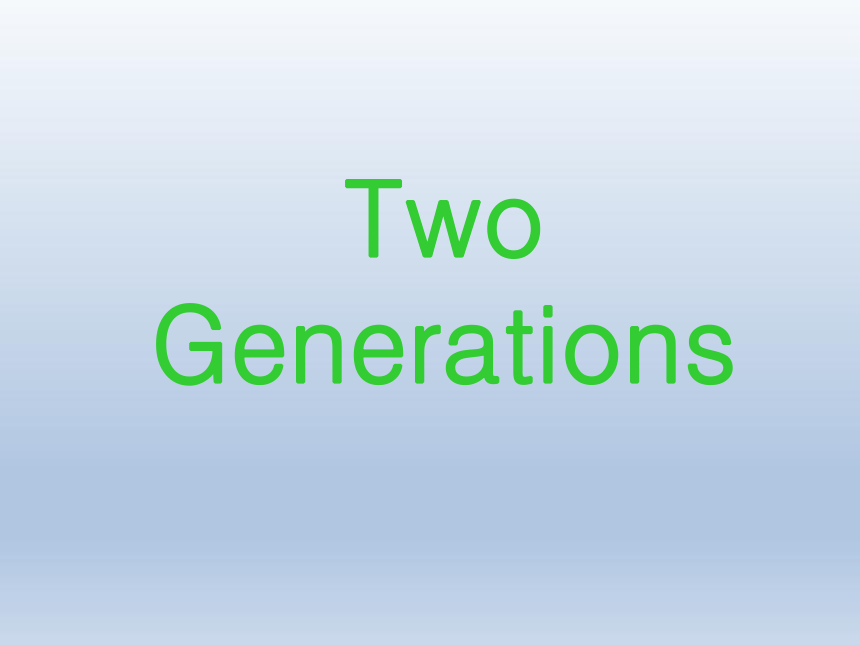 | |
| 格式 | zip | ||
| 文件大小 | 2.2MB | ||
| 资源类型 | 教案 | ||
| 版本资源 | 上海新世纪版 | ||
| 科目 | 英语 | ||
| 更新时间 | 2020-02-26 20:47:23 | ||
图片预览

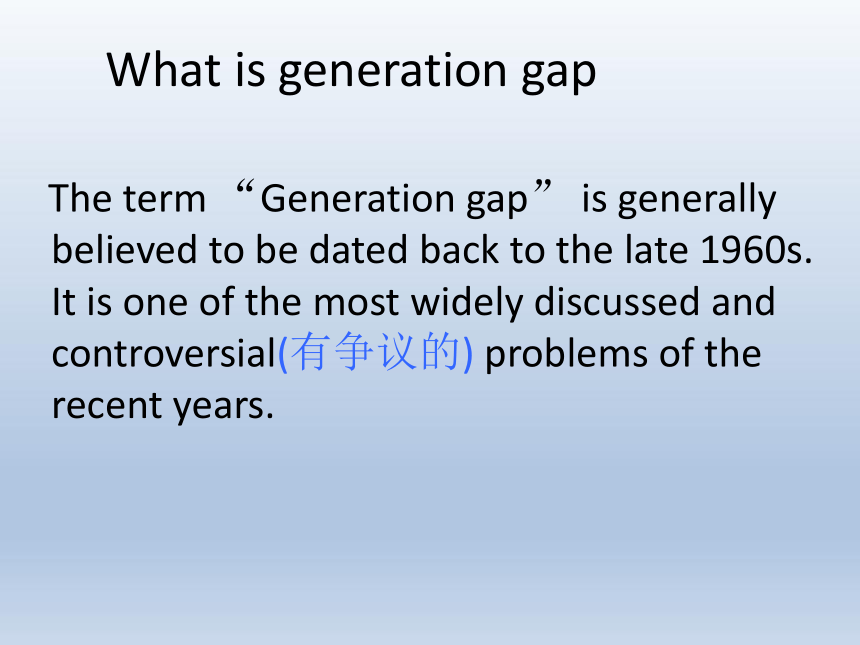

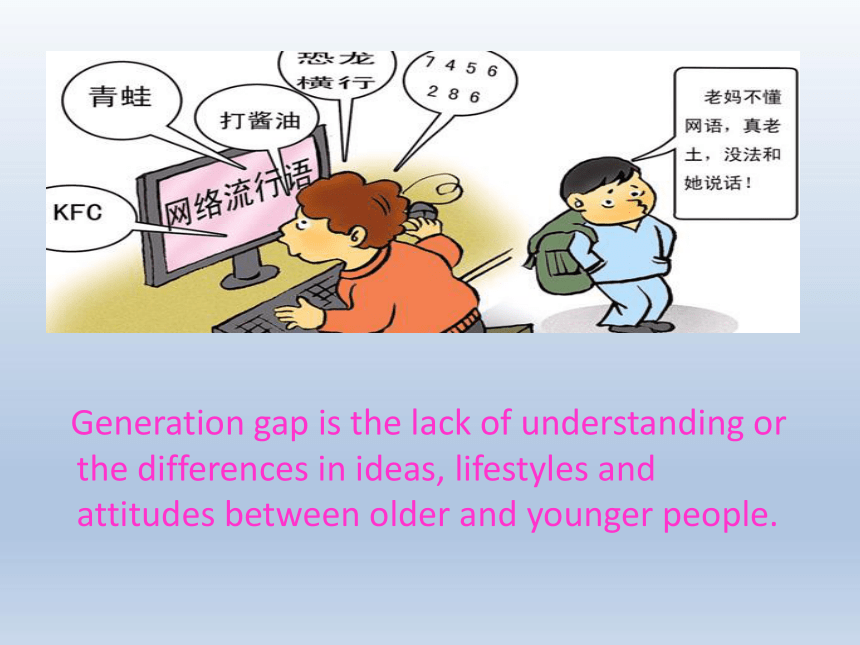
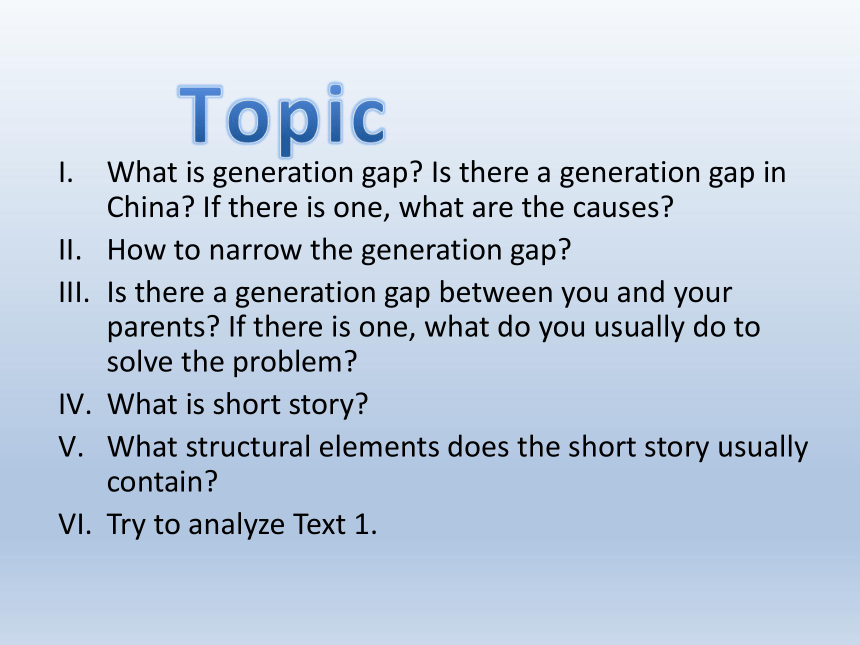
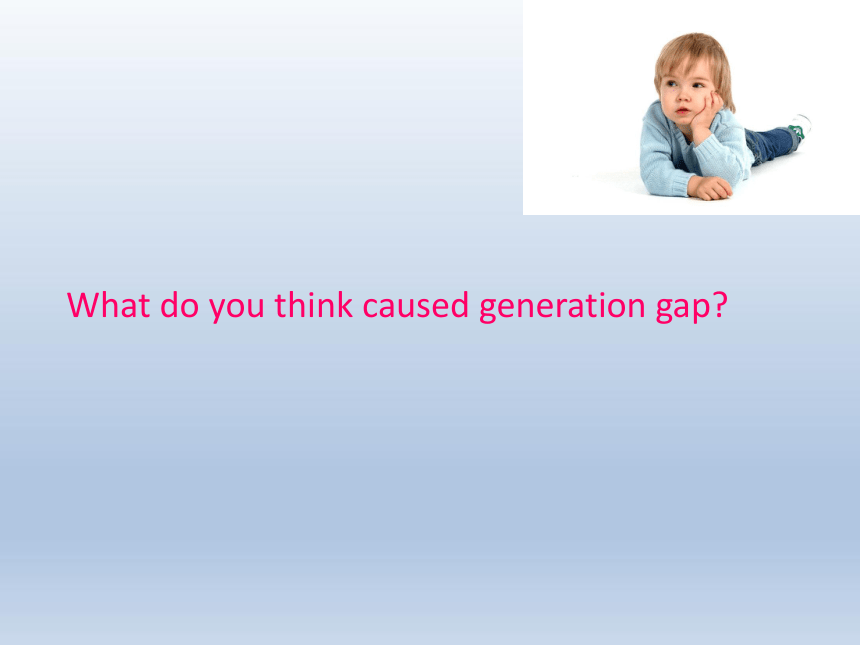
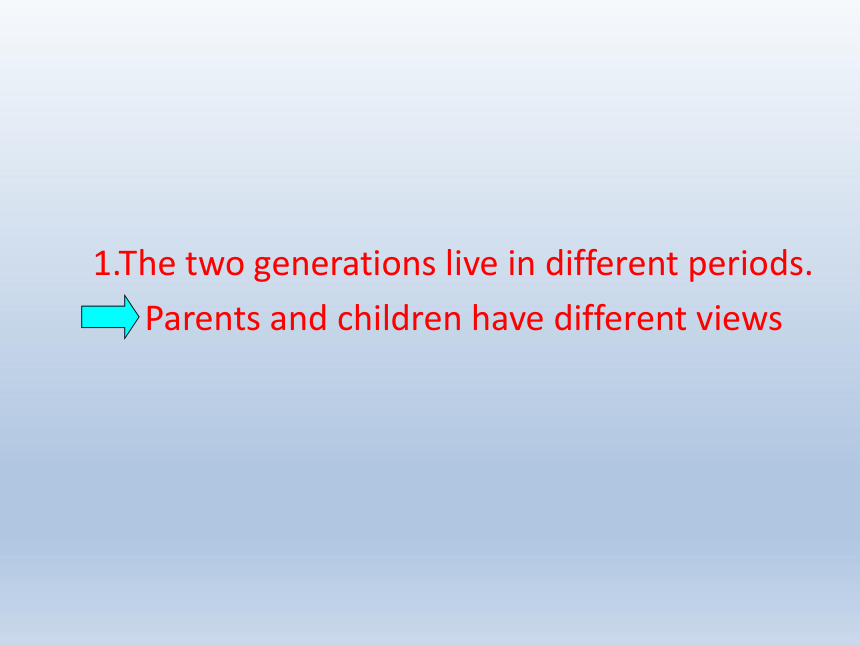

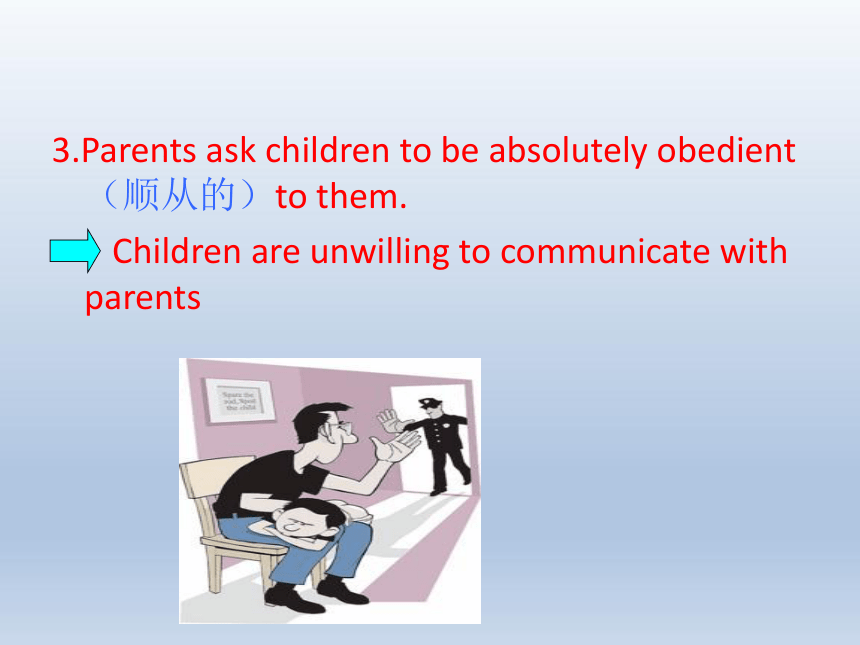
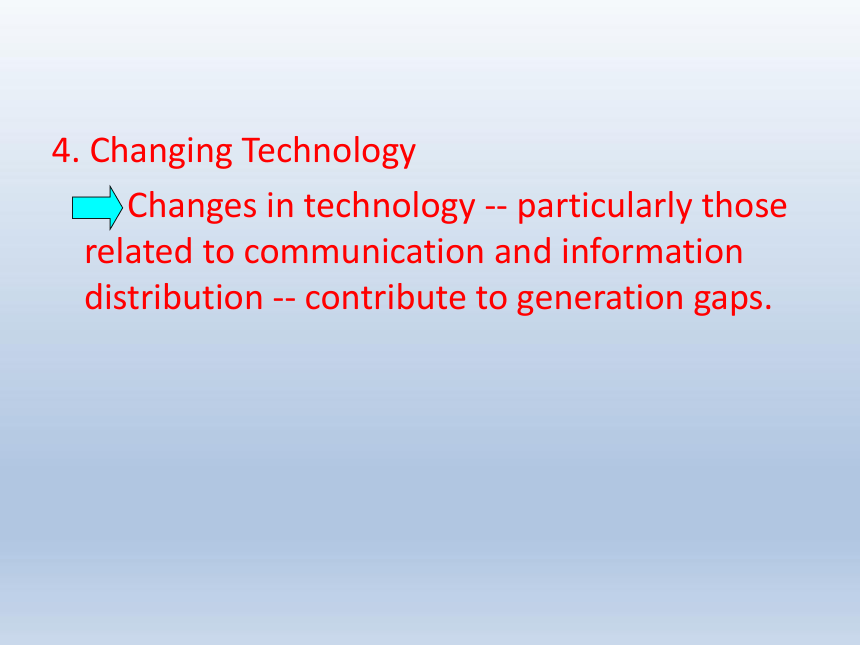
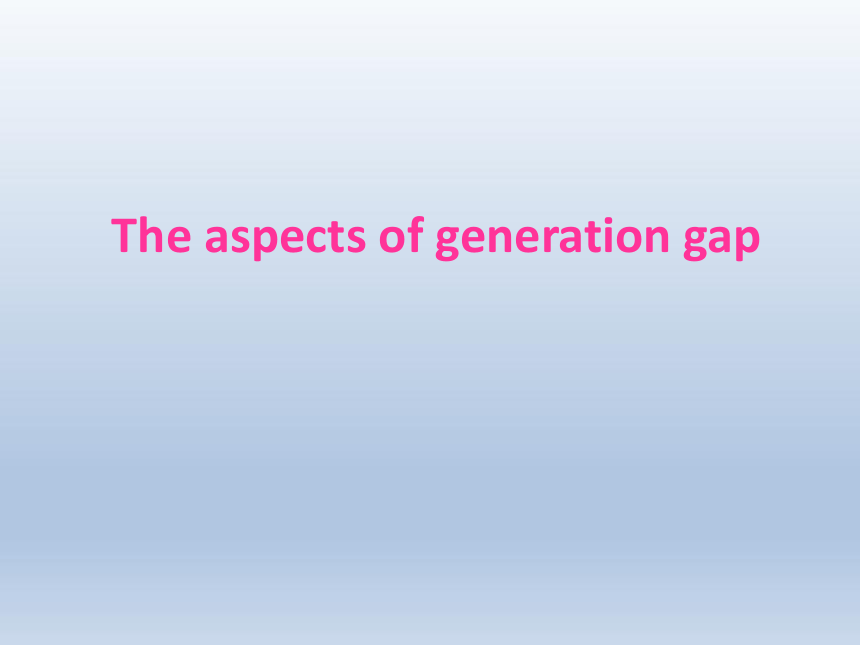

文档简介
(共32张PPT)
Two Generations
What is generation gap
The term “Generation gap” is generally believed to be dated back to the late 1960s. It is one of the most widely discussed and controversial(有争议的) problems of the recent years.
Generation gap is the lack of understanding or the differences in ideas, lifestyles and attitudes between older and younger people.
What is generation gap? Is there a generation gap in China? If there is one, what are the causes?
How to narrow the generation gap?
Is there a generation gap between you and your parents? If there is one, what do you usually do to solve the problem?
What is short story?
What structural elements does the short story usually contain?
Try to analyze Text 1.
Topic
What do you think caused generation gap?
1.The two generations live in different periods.
Parents and children have different views
2.Parents are busy with work.
Parents rarely communicate with children.
3.Parents ask children to be absolutely obedient (顺从的)to them.
Children are unwilling to communicate with parents
4. Changing Technology
Changes in technology -- particularly those related to communication and information distribution -- contribute to generation gaps.
The aspects of generation gap
In study
Dad, I’m practising my listening!
Why are you watching movies, not doing your homework?
In daily life
It will make me look fat, and ruin my image!
It’s cold cold today .Why don’t wear lammy(棉袄)?
In the opinion of love
But I love him and he is potential stock.(潜力股)
You can’t marry him ;he has no money!
How to narrow
the generation gap?
Solutions
Stand in the other’s shoes
Give each other chances of understanding and making mistakes
Be forgiving and considerate
Talk freely and equally
Mother’s Day
Time : second Sunday in May
Flower : Carnation(康乃馨) Day lily?(萱草)
God could not be everywhere and therefore he made mothers. —Jewish proverb
上帝不能无处不在,因此他创造了母亲。 ——犹太谚语
Fathers’ Day
Time:the third Sunday in June
Flowers : white rose(白玫瑰) and sunflower(向日葵)
Is there a generation gap between you and your parents? If there is one, what do you usually do to solve the problem?
Short play show
Scene one:
Mom is reading the newspaper;the daughter comes in.She tells the mom: ‘I am invited to a party.’ But it is very far from home.
Scene two:
Mom do not allowed her to the party. It is too dangerous.
The girl is angry with the mom.
Scene three:
Several days later,
Mom accepts the truth and gives the daughter some advice .
Scene four:
The daughter is going to the party, sent by her mom.
Scene five:
The daughter comes home very happily.
Attention is a concern, is love for the child, and to understand the child, they hope the better growth, this is good, but cannot excessive attention, to give children free and personal space
“Attention "to the child please don't " shut” children“关注”孩子请不要“关住”孩子
Parents can observe their children's behavior at the same time in order to understand heir children's personality as it can reduce the quarrel between them .
advice
Definition
short story is a fiction prose tale of no specified length, but too short to be published as a volume on its own, as novellas sometimes and novels usually are. A short story will normally concentrate on a single event with only one or two characters, more economically than a novel's sustained exploration of social background.
Elements of a Short Story
Theme
Setting
Point of view /narrator
Characters and Characterization
Plot
- exposition
- complication
- climax
- resolution
Text 1 The Law vs. the Piano
Text 2 Bricklayer’s Boy
Structure of the text
1)Susie was guided to study law at an early age.(para. 1-3)
2)Susie fell in love with piano, which gradually engenders a strong dispute between her and her father .(para. 4-7)
3)The compromise led to Susie’s completion in law school and her intention of becoming a pianist.
(para.8-10)
4)Susie became a concert pianist.
(para. 11)
Two Generations
What is generation gap
The term “Generation gap” is generally believed to be dated back to the late 1960s. It is one of the most widely discussed and controversial(有争议的) problems of the recent years.
Generation gap is the lack of understanding or the differences in ideas, lifestyles and attitudes between older and younger people.
What is generation gap? Is there a generation gap in China? If there is one, what are the causes?
How to narrow the generation gap?
Is there a generation gap between you and your parents? If there is one, what do you usually do to solve the problem?
What is short story?
What structural elements does the short story usually contain?
Try to analyze Text 1.
Topic
What do you think caused generation gap?
1.The two generations live in different periods.
Parents and children have different views
2.Parents are busy with work.
Parents rarely communicate with children.
3.Parents ask children to be absolutely obedient (顺从的)to them.
Children are unwilling to communicate with parents
4. Changing Technology
Changes in technology -- particularly those related to communication and information distribution -- contribute to generation gaps.
The aspects of generation gap
In study
Dad, I’m practising my listening!
Why are you watching movies, not doing your homework?
In daily life
It will make me look fat, and ruin my image!
It’s cold cold today .Why don’t wear lammy(棉袄)?
In the opinion of love
But I love him and he is potential stock.(潜力股)
You can’t marry him ;he has no money!
How to narrow
the generation gap?
Solutions
Stand in the other’s shoes
Give each other chances of understanding and making mistakes
Be forgiving and considerate
Talk freely and equally
Mother’s Day
Time : second Sunday in May
Flower : Carnation(康乃馨) Day lily?(萱草)
God could not be everywhere and therefore he made mothers. —Jewish proverb
上帝不能无处不在,因此他创造了母亲。 ——犹太谚语
Fathers’ Day
Time:the third Sunday in June
Flowers : white rose(白玫瑰) and sunflower(向日葵)
Is there a generation gap between you and your parents? If there is one, what do you usually do to solve the problem?
Short play show
Scene one:
Mom is reading the newspaper;the daughter comes in.She tells the mom: ‘I am invited to a party.’ But it is very far from home.
Scene two:
Mom do not allowed her to the party. It is too dangerous.
The girl is angry with the mom.
Scene three:
Several days later,
Mom accepts the truth and gives the daughter some advice .
Scene four:
The daughter is going to the party, sent by her mom.
Scene five:
The daughter comes home very happily.
Attention is a concern, is love for the child, and to understand the child, they hope the better growth, this is good, but cannot excessive attention, to give children free and personal space
“Attention "to the child please don't " shut” children“关注”孩子请不要“关住”孩子
Parents can observe their children's behavior at the same time in order to understand heir children's personality as it can reduce the quarrel between them .
advice
Definition
short story is a fiction prose tale of no specified length, but too short to be published as a volume on its own, as novellas sometimes and novels usually are. A short story will normally concentrate on a single event with only one or two characters, more economically than a novel's sustained exploration of social background.
Elements of a Short Story
Theme
Setting
Point of view /narrator
Characters and Characterization
Plot
- exposition
- complication
- climax
- resolution
Text 1 The Law vs. the Piano
Text 2 Bricklayer’s Boy
Structure of the text
1)Susie was guided to study law at an early age.(para. 1-3)
2)Susie fell in love with piano, which gradually engenders a strong dispute between her and her father .(para. 4-7)
3)The compromise led to Susie’s completion in law school and her intention of becoming a pianist.
(para.8-10)
4)Susie became a concert pianist.
(para. 11)
